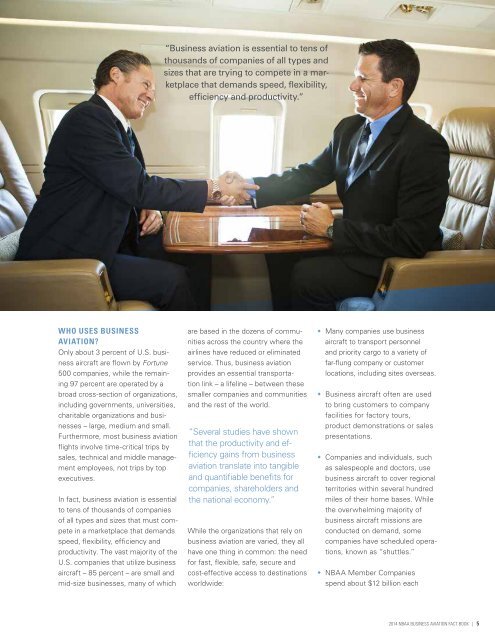business-aviation-fact-book-2014
business-aviation-fact-book-2014
business-aviation-fact-book-2014
Create successful ePaper yourself
Turn your PDF publications into a flip-book with our unique Google optimized e-Paper software.
“Business <strong>aviation</strong> is essential to tens of<br />
thousands of companies of all types and<br />
sizes that are trying to compete in a marketplace<br />
that demands speed, flexibility,<br />
efficiency and productivity.”<br />
Who Uses Business<br />
Aviation?<br />
Only about 3 percent of U.S. <strong>business</strong><br />
aircraft are flown by Fortune<br />
500 companies, while the remaining<br />
97 percent are operated by a<br />
broad cross-section of organizations,<br />
including governments, universities,<br />
charitable organizations and <strong>business</strong>es<br />
– large, medium and small.<br />
Furthermore, most <strong>business</strong> <strong>aviation</strong><br />
flights involve time-critical trips by<br />
sales, technical and middle management<br />
employees, not trips by top<br />
executives.<br />
In <strong>fact</strong>, <strong>business</strong> <strong>aviation</strong> is essential<br />
to tens of thousands of companies<br />
of all types and sizes that must compete<br />
in a marketplace that demands<br />
speed, flexibility, efficiency and<br />
productivity. The vast majority of the<br />
U.S. companies that utilize <strong>business</strong><br />
aircraft – 85 percent – are small and<br />
mid-size <strong>business</strong>es, many of which<br />
are based in the dozens of communities<br />
across the country where the<br />
airlines have reduced or eliminated<br />
service. Thus, <strong>business</strong> <strong>aviation</strong><br />
provides an essential transportation<br />
link – a lifeline – between these<br />
smaller companies and communities<br />
and the rest of the world.<br />
“Several studies have shown<br />
that the productivity and efficiency<br />
gains from <strong>business</strong><br />
<strong>aviation</strong> translate into tangible<br />
and quantifiable benefits for<br />
companies, shareholders and<br />
the national economy.”<br />
While the organizations that rely on<br />
<strong>business</strong> <strong>aviation</strong> are varied, they all<br />
have one thing in common: the need<br />
for fast, flexible, safe, secure and<br />
cost-effective access to destinations<br />
worldwide:<br />
• Many companies use <strong>business</strong><br />
aircraft to transport personnel<br />
and priority cargo to a variety of<br />
far-flung company or customer<br />
locations, including sites overseas.<br />
• Business aircraft often are used<br />
to bring customers to company<br />
facilities for <strong>fact</strong>ory tours,<br />
product demonstrations or sales<br />
presentations.<br />
• Companies and individuals, such<br />
as salespeople and doctors, use<br />
<strong>business</strong> aircraft to cover regional<br />
territories within several hundred<br />
miles of their home bases. While<br />
the overwhelming majority of<br />
<strong>business</strong> aircraft missions are<br />
conducted on demand, some<br />
companies have scheduled operations,<br />
known as “shuttles.”<br />
• NBAA Member Companies<br />
spend about $12 billion each<br />
<strong>2014</strong> NBAA Business Aviation Fact Book | 5


